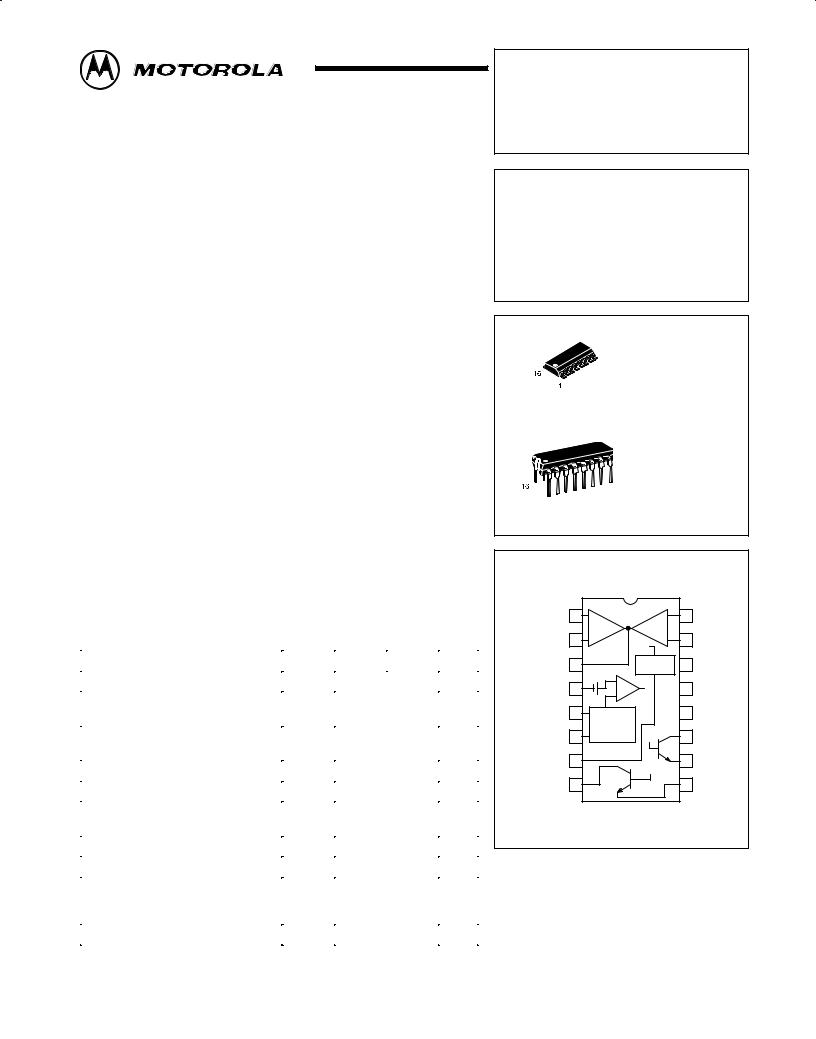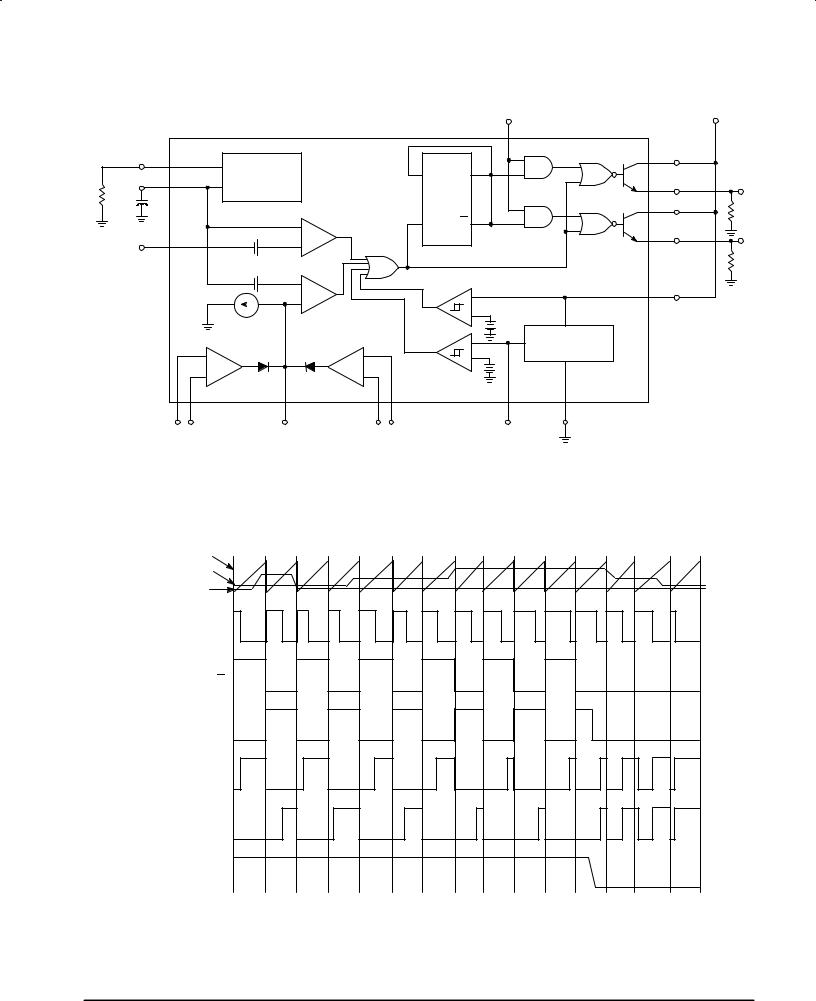Motorola TL494CN, TL494CDR2, TL494CD, TL494IN Datasheet

SWITCHMODE Pulse Width
Modulation Control Circuit
The TL494 is a fixed frequency, pulse width modulation control circuit designed primarily for SWITCHMODE power supply control.
•Complete Pulse Width Modulation Control Circuitry
•On±Chip Oscillator with Master or Slave Operation
•On±Chip Error Amplifiers
•On±Chip 5.0 V Reference
•Adjustable Deadtime Control
•Uncommitted Output Transistors Rated to 500 mA Source or Sink
•Output Control for Push±Pull or Single±Ended Operation
•Undervoltage Lockout
Order this document by TL494/D
TL494
SWITCHMODE
PULSE WIDTH MODULATION
CONTROL CIRCUIT
SEMICONDUCTOR
TECHNICAL DATA
D SUFFIX
PLASTIC PACKAGE
CASE 751B
(SO±16)
N SUFFIX
PLASTIC PACKAGE
CASE 648
MAXIMUM RATINGS (Full operating ambient temperature range applies, unless otherwise noted.)
Rating |
Symbol |
TL494C |
TL494I |
Unit |
|
|
|
|
|
Power Supply Voltage |
VCC |
42 |
V |
|
Collector Output Voltage |
VC1, |
42 |
V |
|
|
VC2 |
|
|
|
Collector Output Current |
IC1, IC2 |
500 |
mA |
|
(Each transistor) (Note 1) |
|
|
|
|
|
|
|
|
|
Amplifier Input Voltage Range |
VIR |
±0.3 to +42 |
V |
|
Power Dissipation @ TA ≤ 45°C |
PD |
1000 |
mW |
|
Thermal Resistance, |
RθJA |
80 |
°C/W |
|
Junction±to±Ambient |
|
|
|
|
|
|
|
|
|
Operating Junction Temperature |
TJ |
125 |
°C |
|
Storage Temperature Range |
Tstg |
±55 to +125 |
°C |
|
Operating Ambient Temperature Range |
TA |
|
|
°C |
TL494C |
|
0 to +70 |
|
|
TL494I |
|
± 25 to +85 |
|
|
|
|
|
|
|
Derating Ambient Temperature |
TA |
45 |
°C |
|
NOTE: 1. Maximum thermal limits must be observed.
PIN CONNECTIONS
Noninv |
1 |
+ |
|
|
+ |
16 |
Noninv |
Input |
1 |
2 |
Input |
||||
Inv |
|
Error |
Error |
|
Inv |
||
|
Amp |
|
|
Amp |
|
||
Input |
2 |
± |
|
VCC |
± |
15 |
Input |
|
|
|
|||||
Compen/PWN |
3 |
|
|
|
5.0 V |
14 |
V |
Comp Input |
|
≈ 0.1 V |
|
|
REF |
|
ref |
Deadtime |
|
|
|
|
|
Output |
|
4 |
|
|
|
|
13 |
||
Control |
|
|
|
|
Control |
||
CT |
5 |
Oscillator |
|
|
12 |
VCC |
|
|
|
|
|
|
|
||
RT |
6 |
|
|
|
Q2 |
11 |
C2 |
|
|
|
|
|
|
|
|
Ground |
7 |
|
|
|
|
10 |
E2 |
C1 |
8 |
|
Q1 |
|
|
9 |
E1 |
|
|
|
|
||||
(Top View)
ORDERING INFORMATION
|
Operating |
|
|
Device |
Temperature Range |
Package |
|
|
|
|
|
TL494CD |
TA = 0° to +70°C |
SO±16 |
|
|
|
||
TL494CN |
Plastic |
||
|
|||
|
|
|
|
TL494IN |
TA = ± 25° to +85°C |
Plastic |
Motorola, Inc. 1996 |
Rev 1 |

TL494
RECOMMENDED OPERATING CONDITIONS
Characteristics |
Symbol |
Min |
Typ |
Max |
Unit |
|
|
|
|
|
|
Power Supply Voltage |
VCC |
7.0 |
15 |
40 |
V |
Collector Output Voltage |
VC1, VC2 |
± |
30 |
40 |
V |
Collector Output Current (Each transistor) |
IC1, IC2 |
± |
± |
200 |
mA |
Amplified Input Voltage |
Vin |
±0.3 |
± |
VCC ± 2.0 |
V |
Current Into Feedback Terminal |
lfb |
± |
± |
0.3 |
mA |
Reference Output Current |
lref |
± |
± |
10 |
mA |
Timing Resistor |
RT |
1.8 |
30 |
500 |
kΩ |
Timing Capacitor |
CT |
0.0047 |
0.001 |
10 |
μF |
Oscillator Frequency |
fosc |
1.0 |
40 |
200 |
kHz |
ELECTRICAL CHARACTERISTICS (VCC = 15 V, CT = 0.01 μF, RT = 12 kΩ, unless otherwise noted.)
For typical values TA = 25°C, for min/max values TA is the operating ambient temperature range that applies, unless otherwise noted.
Characteristics |
Symbol |
Min |
Typ |
Max |
Unit |
|
|
|
|
|
|
REFERENCE SECTION |
|
|
|
|
|
|
|
|
|
|
|
Reference Voltage (IO = 1.0 mA) |
Vref |
4.75 |
5.0 |
5.25 |
V |
Line Regulation (VCC = 7.0 V to 40 V) |
Regline |
± |
2.0 |
25 |
mV |
Load Regulation (IO = 1.0 mA to 10 mA) |
Regload |
± |
3.0 |
15 |
mV |
Short Circuit Output Current (Vref = 0 V) |
ISC |
15 |
35 |
75 |
mA |
OUTPUT SECTION |
|
|
|
|
|
|
|
|
|
|
|
Collector Off±State Current |
IC(off) |
± |
2.0 |
100 |
μA |
(VCC = 40 V, VCE = 40 V) |
|
|
|
|
|
Emitter Off±State Current |
IE(off) |
± |
± |
±100 |
μA |
VCC = 40 V, VC = 40 V, VE = 0 V) |
|
|
|
|
|
Collector±Emitter Saturation Voltage (Note 2) |
|
|
|
|
V |
Common±Emitter (VE = 0 V, IC = 200 mA) |
Vsat(C) |
± |
1.1 |
1.3 |
|
Emitter±Follower (VC = 15 V, IE = ±200 mA) |
Vsat(E) |
± |
1.5 |
2.5 |
|
Output Control Pin Current |
|
|
|
|
|
Low State (VOC ≤ 0.4 V) |
IOCL |
± |
10 |
± |
μA |
High State (VOC = Vref) |
IOCH |
± |
0.2 |
3.5 |
mA |
Output Voltage Rise Time |
tr |
|
|
|
ns |
Common±Emitter (See Figure 12) |
|
± |
100 |
200 |
|
Emitter±Follower (See Figure 13) |
|
± |
100 |
200 |
|
|
|
|
|
|
|
Output Voltage Fall Time |
tf |
|
|
|
ns |
Common±Emitter (See Figure 12) |
|
± |
25 |
100 |
|
Emitter±Follower (See Figure 13) |
|
± |
40 |
100 |
|
|
|
|
|
|
|
NOTE: 2. Low duty cycle pulse techniques are used during test to maintain junction temperature as close to ambient temperature as possible.
2 |
MOTOROLA ANALOG IC DEVICE DATA |

TL494
ELECTRICAL CHARACTERISTICS (VCC = 15 V, CT = 0.01 μF, RT = 12 kΩ, unless otherwise noted.)
For typical values TA = 25°C, for min/max values TA is the operating ambient temperature range that applies, unless otherwise noted.
Characteristics |
Symbol |
|
Min |
|
Typ |
|
Max |
Unit |
||||||
|
|
|
|
|
|
|
|
|
|
|
|
|
|
|
ERROR AMPLIFIER SECTION |
|
|
|
|
|
|
|
|
|
|
|
|
|
|
|
|
|
|
|
|
|
|
|
|
|
|
|
|
|
Input Offset Voltage (VO (Pin 3) = 2.5 V) |
VIO |
|
|
± |
|
2.0 |
|
|
10 |
mV |
||||
Input Offset Current (VO (Pin 3) = 2.5 V) |
IIO |
|
|
± |
|
5.0 |
|
|
250 |
nA |
||||
Input Bias Current (VO (Pin 3) = 2.5 V) |
IIB |
|
|
± |
|
±0.1 |
|
±1.0 |
μA |
|||||
Input Common Mode Voltage Range (VCC = 40 V, TA = 25°C) |
VICR |
|
|
|
|
|
±0.3 to VCC±2.0 |
|
V |
|||||
Open Loop Voltage Gain ( VO = 3.0 V, VO = 0.5 V to 3.5 V, RL = 2.0 kΩ) |
AVOL |
|
|
70 |
|
95 |
|
|
± |
dB |
||||
Unity±Gain Crossover Frequency (VO = 0.5 V to 3.5 V, RL = 2.0 kΩ) |
fC± |
|
|
± |
|
350 |
|
|
± |
kHz |
||||
Phase Margin at Unity±Gain (VO = 0.5 V to 3.5 V, RL = 2.0 kΩ) |
φm |
|
|
± |
|
65 |
|
|
± |
deg. |
||||
Common Mode Rejection Ratio (VCC = 40 V) |
CMRR |
|
65 |
|
90 |
|
|
± |
dB |
|||||
Power Supply Rejection Ratio ( VCC = 33 V, VO = 2.5 V, RL = 2.0 kΩ) |
PSRR |
|
± |
|
100 |
|
|
± |
dB |
|||||
Output Sink Current (VO (Pin 3) = 0.7 V) |
IO± |
|
|
0.3 |
|
0.7 |
|
|
± |
mA |
||||
Output Source Current (VO (Pin 3) = 3.5 V) |
IO+ |
|
|
2.0 |
|
±4.0 |
|
± |
mA |
|||||
PWM COMPARATOR SECTION (Test Circuit Figure 11) |
|
|
|
|
|
|
|
|
|
|
|
|
|
|
|
|
|
|
|
|
|
|
|
|
|
|
|
|
|
Input Threshold Voltage (Zero Duty Cycle) |
VTH |
|
|
± |
|
2.5 |
|
|
4.5 |
V |
||||
Input Sink Current (V(Pin 3) = 0.7 V) |
II± |
|
|
0.3 |
|
0.7 |
|
|
± |
mA |
||||
DEADTIME CONTROL SECTION (Test Circuit Figure 11) |
|
|
|
|
|
|
|
|
|
|
|
|
|
|
|
|
|
|
|
|
|
|
|
|
|
|
|||
Input Bias Current (Pin 4) (VPin 4 = 0 V to 5.25 V) |
IIB (DT) |
|
± |
|
±2.0 |
|
±10 |
μA |
||||||
Maximum Duty Cycle, Each Output, Push±Pull Mode |
DCmax |
|
|
|
|
|
|
|
|
|
|
|
% |
|
(VPin 4 = 0 V, CT = 0.01 μF, RT = 12 kΩ) |
|
|
|
45 |
|
48 |
|
|
50 |
|
||||
(VPin 4 = 0 V, CT = 0.001 μF, RT = 30 kΩ) |
|
|
|
± |
|
45 |
|
|
50 |
|
||||
Input Threshold Voltage (Pin 4) |
Vth |
|
|
|
|
|
|
|
|
|
|
|
|
V |
(Zero Duty Cycle) |
|
|
|
± |
|
2.8 |
|
|
3.3 |
|
||||
(Maximum Duty Cycle) |
|
|
|
0 |
|
± |
|
|
± |
|
||||
|
|
|
|
|
|
|
|
|
|
|
|
|
|
|
OSCILLATOR SECTION |
|
|
|
|
|
|
|
|
|
|
|
|
|
|
|
|
|
|
|
|
|
|
|
|
|
|
|
|
|
Frequency (CT = 0.001 μF, RT = 30 kΩ) |
fosc |
|
|
± |
|
40 |
|
|
± |
kHz |
||||
Standard Deviation of Frequency* (CT = 0.001 μF, RT = 30 kΩ) |
σfosc |
|
|
± |
|
3.0 |
|
|
± |
% |
||||
Frequency Change with Voltage (VCC = 7.0 V to 40 V, TA = 25°C) |
fosc ( |
V) |
|
± |
|
0.1 |
|
|
± |
% |
||||
Frequency Change with Temperature ( TA = Tlow to Thigh) |
fosc ( |
T) |
|
± |
|
± |
|
|
12 |
% |
||||
(CT = 0.01 μF, RT = 12 kΩ) |
|
|
|
|
|
|
|
|
|
|
|
|
|
|
UNDERVOLTAGE LOCKOUT SECTION |
|
|
|
|
|
|
|
|
|
|
|
|
|
|
|
|
|
|
|
|
|
|
|
|
|
|
|
|
|
Turn±On Threshold (VCC increasing, Iref = 1.0 mA) |
Vth |
|
|
5.5 |
|
6.43 |
|
7.0 |
V |
|||||
TOTAL DEVICE |
|
|
|
|
|
|
|
|
|
|
|
|
|
|
|
|
|
|
|
|
|
|
|
|
|
|
|
|
|
Standby Supply Current (Pin 6 at Vref, All other inputs and outputs open) |
ICC |
|
|
|
|
|
|
|
|
|
|
|
|
mA |
(VCC = 15 V) |
|
|
|
± |
|
5.5 |
|
|
10 |
|
||||
(VCC = 40 V) |
|
|
|
± |
|
7.0 |
|
|
15 |
|
||||
Average Supply Current |
|
|
|
|
|
|
|
|
|
|
|
|
|
mA |
(CT = 0.01 μF, RT = 12 kΩ, V(Pin 4) = 2.0 V) |
|
|
|
± |
|
7.0 |
|
|
± |
|
||||
(VCC = 15 V) (See Figure 12) |
|
|
|
|
|
|
|
|
|
|
|
|
|
|
|
|
|
|
|
|
|
|
|
|
|
|
|
||
|
|
|
|
|
|
|
N |
|
|
|
|
|||
|
|
|
|
|
|
|
|
|
|
|||||
* Standard deviation is a measure of the statistical distribution about the mean as derived from the formula, σ |
|
|
|
Σ (Xn ± X)2 |
|
|
||||||||
|
|
|
n = 1 |
|
|
|
||||||||
|
|
|
|
|
|
|
N ± 1 |
|
|
|||||
|
|
|
|
|
|
|
|
|
|
|
|
|
|
|
MOTOROLA ANALOG IC DEVICE DATA |
3 |
|

TL494
Figure 1. Representative Block Diagram
|
|
|
|
|
|
|
|
|
Output Control |
|
VCC |
|
|
|
|
|
|
|
|
|
13 |
|
|
|
6 |
|
|
|
|
|
|
|
|
|
8 |
|
|
|
|
|
|
|
|
|
|
|
|
|
|
|
Oscillator |
|
|
|
D |
Q |
|
Q1 |
9 |
RT |
5 |
|
|
|
|
|
Flip± |
|
|
|
|
|
|
|
|
|
|
|
|
|
|||
|
CT |
|
|
Deadtime |
|
|
Flop |
|
|
|
|
|
|
|
|
Comparator |
|
|
Ck |
Q |
|
Q2 |
11 |
|
|
|
0.12V |
± |
|
|
|
||||
|
|
|
+ |
|
|
|
|
|
|
|
|
|
4 |
|
|
|
|
|
|
|
|
10 |
|
|
|
|
|
|
|
|
|
|
|
||
|
|
|
|
|
|
|
|
|
|
|
|
|
Deadtime |
|
0.7V |
|
|
|
|
|
|
|
|
|
Control |
|
|
± |
|
|
|
|
|
|
12 |
|
|
|
|
|
|
|
|
± |
|
|
|
|
|
|
|
+ |
|
|
|
|
|
VCC |
|
|
|
|
|
|
|
|
+ |
4.9V |
|
||
|
|
|
0.7mA |
PWM |
|
|
UV |
|
|||
|
|
|
Comparator |
|
|
|
|
|
|||
|
|
|
|
|
|
|
Lockout |
± |
|
Reference |
|
|
|
+ |
|
+ |
|
|
|
|
Regulator |
|
|
|
|
|
|
|
|
+ |
|
|
|||
|
|
|
|
|
|
|
|
|
|||
|
|
1 |
|
2 |
|
|
|
|
|
|
|
|
|
|
|
|
|
|
|
|
|
||
|
|
± |
|
± |
|
|
|
3.5V |
|
|
|
|
1 |
2 |
|
3 |
15 |
16 |
|
|
14 |
7 |
|
|
Error Amp |
Feedback PWM |
Error Amp |
|
|
Ref. |
Gnd |
|
|||
|
|
|
|
|
|||||||
|
|
1 |
Comparator Input |
|
2 |
|
|
Output |
|
|
|
This device contains 46 active transistors.
Figure 2. Timing Diagram
Capacitor CT |
Feedback/PWM Comp. |
Deadtime Control |
Flip±Flop |
Clock Input |
Flip±Flop |
Q |
Flip±Flop |
Q |
Output Q1 |
Emitter |
Output Q2 |
Emitter |
Output |
Control |
4 |
MOTOROLA ANALOG IC DEVICE DATA |
